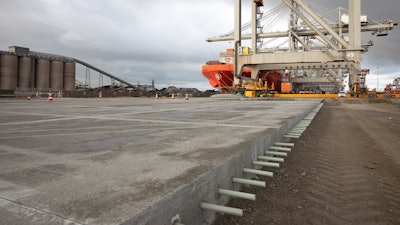Composites: The Future of Sustainable Construction Products
Composites: The Future of Sustainable Construction Products
Blog Article
Unlocking the Environmental Advantages of Recycled Compounds in Building And Construction and Layout
In the world of building and style, the application of recycled compounds holds significant promise for boosting sustainability practices and lowering environmental influence (composites). By integrating these ingenious products, there is a potential to resolve essential issues such as waste reduction, power preservation, and a reduction in carbon impact. The shift towards an extra lasting future in these sectors depends upon unlocking the full possibility of recycled composites. This discussion will check out the complex benefits and challenges connected with incorporating recycled composites into building and construction and style, supplying a glance right into the transformative opportunities that lie in advance.

Environmental Impact Reduction
The reduction of ecological influence with the use of recycled compounds in building and design plays a crucial function in sustainable techniques. By integrating recycled compounds into building products, the building industry can substantially reduce its carbon impact and add to a more eco-friendly future. These sustainable materials, made from repurposed plastics, wood fibers, or various other recycled elements, supply a sensible alternative to traditional construction products without compromising on top quality or durability.
Recycled compounds assist divert waste from land fills and lower the demand for drawing out resources, thus preserving natural resources. Additionally, the manufacturing process of these composites often takes in less power and produces fewer greenhouse gases contrasted to creating virgin products (composites). This shift towards using recycled compounds not just decreases ecological damage however also promotes a circular economy by urging the reuse of products that would certainly otherwise be discarded
Waste Reduction
With a concentrate on decreasing waste in construction and design, the combination of recycled compounds uses a lasting service to reduce environmental influence. Waste reduction is an important facet of lasting techniques, and making use of recycled composites offers a possibility to attain this objective effectively. By utilizing products that have actually already offered their preliminary purpose, such as recycled plastics or recovered wood fibers, the construction and design sectors can considerably decrease the amount of waste produced and sent out to garbage dumps.
Recycled compounds have the potential to draw away substantial quantities of waste from standard disposal techniques, adding to a much more round economic situation where resources are used efficiently. In addition, the production process of recycled composites typically takes in much less energy and generates less emissions contrasted to virgin products, even more reducing the ecological footprint of building and construction and design projects.
Carrying out waste minimization methods via the incorporation of recycled composites not just aids in saving natural sources but likewise advertises a more lasting approach to building and making for a greener future.
Energy Conservation
Incorporating recycled compounds not only minimizes waste in building and layout however also plays a crucial role in improving energy preservation methods within the industry. The usage of recycled compounds in construction Learn More Here can considerably contribute to energy preservation through different means. By advertising the use of recycled compounds in building and construction and layout, the industry can make substantial strides in the direction of accomplishing power effectiveness and reducing its carbon impact, eventually contributing to a much more lasting developed setting.
Carbon Footprint Reduction
Enhancing sustainability methods via the usage of recycled composites in building and construction and style substantially minimizes the carbon footprint of the sector. By incorporating recycled materials into the manufacturing of compounds, the demand for virgin sources decreases, causing lower power consumption and greenhouse gas exhausts connected with standard manufacturing processes. This decrease in carbon impact is essential in combating environment modification and promoting a much more eco friendly method to building and construction and design.
Moreover, the use of recycled composites likewise helps in diverting waste from land fills, thereby mitigating the ecological influence of disposal and promoting a circular economic situation. The carbon footprint decrease accomplished via the fostering of recycled composites lines up with Read Full Article the international push in the direction of sustainable practices and the decrease of commercial discharges. It showcases a dedication to accountable source administration and a shift in the direction of greener alternatives in the building and construction and design sectors. Ultimately, by focusing on the assimilation of recycled composites, the market can make substantial strides in lowering its carbon impact and adding to an extra lasting future.
Lasting Future
The assimilation of recycled composites in building and construction and layout not just addresses instant environmental worries yet likewise lays a solid foundation for a lasting future in the industry. By integrating recycled composites right into building products and items, the construction and layout fields can substantially lower their dependence on virgin resources, leading to an extra round economic situation. This shift in the direction of sustainability is critical for reducing the environmental influence of conventional construction practices, which commonly cause high levels of waste generation and source exhaustion.

Conclusion
To conclude, recycled composites provide substantial environmental advantages in construction and layout by decreasing ecological impact, minimizing waste, saving power, lowering carbon footprint, and advertising a sustainable future. Accepting making use of recycled compounds can contribute to a much more navigate to these guys environmentally-friendly strategy to structure and layout, ultimately leading to a much more sustainable and greener future for all.
The decrease of ecological effect via the use of recycled composites in building and design plays an important function in lasting methods.With a focus on reducing waste in building and construction and layout, the combination of recycled composites supplies a sustainable solution to lower environmental impact. By promoting the use of recycled compounds in construction and design, the sector can make substantial strides towards achieving energy effectiveness and minimizing its carbon footprint, eventually adding to a more lasting developed setting.

Report this page